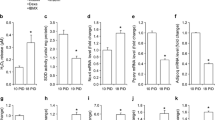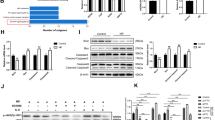Abstract
Background
Despite commonly use for treatment of type II diabetes, possible effects of glipizide on nuclear transport and DNA damage in cells are unknown. Since clinical response of glipizide may change with aging, the aim of the study was to investigate the effect of glipizide by comparing mature and senescent adipocytes.
Methods and results
The effects of glipizide were investigated in 3T3-L1 adipocytes. Effective and lethal doses were determined by real-time monitoring iCELLigence system. Comet assay was performed to determine DNA damage and quantitative PCR was conducted to detect gene expression levels. RAN expressions were found to be up regulated in mature 180 µM glipizide treated adipocytes compared to control group (p < 0.05); whereas down regulated in senescent 180 µM glipizide treated adipocytes compared to their control adipocytes (p < 0.05). Olive Tail Moment values were significantly higher in mature 180 µM glipizide treated adipocytes (MTG) and senescent 180 µM glipizide treated adipocytes (STG) comparing their untreated controls (p < 0.001 and p < 0.001 respectively). Also class 5 comets that shows severe DNA damage were found to be higher in both MTG and STG groups than their controls (p < 0.001 and p < 0.001, respectively). OTM values were higher in STG than MTG (p < 0.001).
Conclusions
This is the first study that reports glipizide caused DNA damage increasing with senescence in adipocytes. As a response to glipizide treatment Ran gene expression increased in mature; and decreased in senescent adipocytes. Further studies are needed to reveal the effect of glipizide on DNA and nuclear interactions in molecular level.




Similar content being viewed by others
Data availability
The data used to support the findings of the present study were included within the article.
References
Cho NM. International Diabetes Federation (2017) Forewords. IDF diabetes atlas-eighth addition. http://fmdiabetes.org/wp-content/uploads/2018/03/IDF-2017.pdf. Accessed Nov 2019
American Diabetes Association (2010) Diagnosis and classification of diabetes mellitus. Diabetes Care 33(Supplement 1):62–69
Krentz AJ, Bailey CJ (2005) Oral antidiabetic agents. Drugs 65(3):385–411. https://doi.org/10.2165/00003495-200565030-00005
Tuzun S, Girgin FK, Sözmen EY, Menteş G, Ersöz B (1999) Antioxidant status in experimental type 2 diabetes mellitus: effects of glibenclamide and glipizide on various rat tissues. Exp Toxicol Pathol 51:436–441. https://doi.org/10.1016/S0940-2993(99)80036-0
Avery MA, Mizuno CS, Chittiboyina AG, Kurtz TW, Pershadsingh HA (2008) Type 2 diabetes and oral antihyperglycemic drugs. Curr Med Chem 15(1):61–74. https://doi.org/10.2174/092986708783330656
Riddle MC (1999) Oral pharmacologic management of type 2 diabetes. Am Fam Physician 60:2613–2620
Marchetti P, Giannarelli R, di Carlo A, Navalesi R (1991) Pharmacokinetic optimisation of oral hypoglycaemic therapy. Clin Pharmacokinet 21(4):308–317. https://doi.org/10.2165/00003088-199121040-00006
Sliwinska A, Blasiak J, Drzewoski J (2006) Effect of gliclazide on DNA damage in human peripheral blood lymphocytes and insulinoma mouse cells. Chem Biol Interact 162:259–267. https://doi.org/10.1016/j.cbi.2006.07.006
Sliwinska A, Blasiak J, Kasznicki J, Drzewoski J (2008) In vitro effect of gliclazide on DNA damage and repair in patients with type 2 diabetes mellitus (T2DM). Chem Biol Interact 173:159–165. https://doi.org/10.1016/j.cbi.2008.03.017
Rabbani SI, Devi K, Khanam S (2009) Inhibitory effect of glimepiride on nicotinamide-streptozotocin induced nuclear damages and sperm abnormality in diabetic Wistar rats. Indian J Exp Biol 47:804–810
de Sant’Anna JR, da Silva Franco CC, de Freitas Mathias PC, de Castro-Prado MA (2015) Assessment of in vivo and in vitro genotoxicity of glibenclamide in eukaryotic cells. PLoS ONE 10:e0120675. https://doi.org/10.1371/journal.pone.0120675
Shaik NA, Shaik JP, Ali S, Imran A, Rao DK (2010) Increased frequency of micronuclei in diabetes mellitus patients using pioglitazone and glimepiride in combination. Food Chem Toxicol 48:3432–3435. https://doi.org/10.1016/j.fct.2010.09.016
Hayflick L, Moorhead PS (1961) The serial cultivation of human diploid cell strains. Exp Cell Res 25(3):585–621. https://doi.org/10.1016/0014-4827(61)90192-6
Passos JF, Saretzki G, Ahmed S et al (2007) Mitochondrial dysfunction accounts for the stochastic heterogeneity in telomere-dependent senescence. PLOS Biol 5(5):e110. https://doi.org/10.1371/journal.pbio.0050110
Chen Q, Fischer A, Reagan JD, Yan LJ, Ames BN (1995) Oxidative DNA damage and senescence of human diploid fibroblast cells. PNAS 92(10):4337–4341. https://doi.org/10.1073/pnas.92.10.4337
Bonomini F, Rodella LF, Rezzani R (2015) Metabolic syndrome, aging and involvement of oxidative stress. Aging Dis 6:109. https://doi.org/10.14336/AD.2014.0305
Lu T, Finkel T (2008) Free radicals and senescence. Exp Cell Res 314(9):1918–1922. https://doi.org/10.1016/j.yexcr.2008.01.011
Xu M, Palmer AK, Ding H et al (2015) Targeting senescent cells enhances adipogenesis and metabolic function in old age. Elife 4:e12997. https://doi.org/10.7554/eLife.12997.002
Xu M, Tchkonia T, Ding H et al (2015) JAK inhibition alleviates the cellular senescence-associated secretory phenotype and frailty in old age. Proc Natl Acad Sci USA 112:6301–6310. https://doi.org/10.1073/pnas.1515386112
Kobayashi KA, Bauer LA, Horn JR, Opheim K, Wood JF, Kradjan WA (1988) Glipizide pharmacokinetics in young and elderly volunteers. Clin Pharm 7(3):224–228
Kradjan WA, Kobayashi KA, Bauer LA, Horn JR, Opheim KE, Wood FJ Jr (1989) Glipizide pharmacokinetics: effects of age, diabetes, and multiple dosing. J Clin Pharmacol 29(12):1121–1127. https://doi.org/10.1002/j.1552-4604.1989.tb03289.x
Dasso M (2002) The Ran GTPase: theme and variations. Curr Biol 12(14):R502–R508. https://doi.org/10.1016/S0960-9822(02)00970-3
Cook A, Bono F, Jinek M, Conti E (2007) Structural biology of nucleocytoplasmic transport. Annu Rev Biochem 76:647–671. https://doi.org/10.1146/annurev.biochem.76.052705.161529
Wilde A, Lizarraga SB, Zhang L et al (2001) Ran stimulates spindle assembly by altering microtubule dynamics and the balance of motor activities. Nat Cell Biol 3:221. https://doi.org/10.1038/35060000
Arnaoutov A, Dasso M (2003) The Ran GTPase regulates kinetochore function. Dev Cell 5:99–111. https://doi.org/10.1016/S1534-5807(03)00194-1
Clarke PR, Zhang C (2008) Spatial and temporal coordination of mitosis by Ran GTPase. Nat Rev Mol Cell Biol 9:464. https://doi.org/10.1038/nrm2410
Wood CD, Thornton TM, Sabio G, Davis RA, Rincon M (2009) Nuclear localization of p38 MAPK in response to DNA damage. Int J Biol Sci 5(5):428. https://doi.org/10.7150/ijbs.5.428
van der Watt PJ, Leaner VD (2011) The nuclear exporter, Crm1, is regulated by NFY and Sp1 in cancer cells and repressed by p53 in response to DNA damage. BBA-Gene Regul Mech 1809(7):316–326. https://doi.org/10.1016/j.bbagrm.2011.05.017
Dworak N, Makosa D, Chatterjee M et al (2019) A nuclear lamina-chromatin-Ran GTPase axis modulates nuclear import and DNA damage signaling. Aging Cell 18(1):e12851. https://doi.org/10.1111/acel.12851
Thompson ME (2010) BRCA1 16 years later: nuclear import and export processes. FEBS J 277:3072–3078. https://doi.org/10.1111/j.1742-4658.2010.07733.x
Blackinton JG, Keene JD (2014) Post-transcriptional RNA regulons affecting cell cycle and proliferation. Semin Cell Dev Biol 34:44–54. https://doi.org/10.1016/j.semcdb.2014.05.014
Cekan P, Hasegawa K, Pan Y et al (2016) RCC1-dependent activation of Ran accelerates cell cycle and DNA repair, inhibiting DNA damage–induced cell senescence. Mol Biol Cell 27(8):1346–1357. https://doi.org/10.1091/mbc.E16-01-0025
Miard S, Dombrowski L, Carter S, Boivin L, Picard F (2009) Aging alters PPARgamma in rodent and human adipose tissue by modulating the balance in steroid receptor coactivator-1. Aging Cell 8:449–459. https://doi.org/10.1111/j.1474-9726.2009.00490.x
Rodier F, Campisi J (2011) Four faces of cellular senescence. J Cell Biol 192(4):547–556. https://doi.org/10.1083/jcb.201009094
Livak KJ, Schmittgen TD (2001) The analysis of relative gene expression data using real-time quantitative PCR and the 2− ΔΔCT method. Methods 25(4):402–408. https://doi.org/10.1006/meth.2001.1262
McKelvey-Martin VJ, Green MH, Schmezer P, Pool-Zobel BL, De Meo MP, Collins A (1993) The single cell gel electrophoresis assay (comet assay): a European review. Mutat Res 288:47–63. https://doi.org/10.1016/0027-5107(93)90207-v
Forchhammer L, Johansson C, Loft S et al (2010) Variation in the measurement of DNA damage by comet assay measured by the ECVAG† inter-laboratory validation trial. Mutagenesis 25(2):113–123. https://doi.org/10.1093/mutage/gep048
Miyamae Y, Yamamoto M, Sasaki YF et al (1998) Evaluation of a tissue homogenization technique that isolates nuclei for the in vivo single cell gel electrophoresis (comet) assay: a collaborative study by five laboratories. Mutat Res Genet Toxicol Environ Mutagen 418(2–3):131–140. https://doi.org/10.1016/S1383-5718(98)00112-0
Baltaci V, Aygün N, Akyol D, Karakaya AE, Şardaş S (1998) Chromosomal aberrations and alkaline comet assay in families with habitual abortion. M Mutat Res Genet Toxicol Environ Mutagen 417(1):47–55. https://doi.org/10.1016/S1383-5718(98)00097-7
Buchwalter A, Hetzer MW (2017) Nucleolar expansion and elevated protein translation in premature aging. Nat Commun 8(1):1–13. https://doi.org/10.1038/s41467-017-00322-z
Bridger JM, Kill IR (2004) Aging of Hutchinson-Gilford progeria syndrome fibroblasts is characterised by hyperproliferation and increased apoptosis. Exp Gerontol 39(5):717–724. https://doi.org/10.1016/j.exger.2004.02.002
Swanson EC, Manning B, Zhang H, Lawrence JB (2013) Higher-order unfolding of satellite heterochromatin is a consistent and early event in cell senescence. J Cell Biol 203(6):929–942. https://doi.org/10.1083/jcb.201306073
Hoeijmakers JH (2009) DNA damage, aging, and cancer. N Engl J Med 361:1475–1485. https://doi.org/10.1074/jbc.M115.681908
Roos WP, Thomas AD, Kaina B (2016) DNA damage and the balance between survival and death in cancer biology. Nat Rev Cancer 16(1):20–33. https://doi.org/10.1038/nrc.2015.2
Vigneri P, Frasca F, Sciacca L, Pandini G, Vigneri R (2009) Diabetes and cancer. Endocr Relat Cancer 16(4):1103–1123. https://doi.org/10.1677/ERC-09-0087
Drivas GT, Shih A, Coutavas E, Rush MG, D’eustachio P (1990) Characterization of four novel ras-like genes expressed in a human teratocarcinoma cell line. Mol Cell Biol 10(4):1793–1798. https://doi.org/10.1128/MCB.10.4.1793
Ye F, Zhang H, Yang YX et al (2011) Comparative proteome analysis of 3T3-L1 adipocyte differentiation using iTRAQ-coupled 2D LC-MS/MS. J Cell Biochem 112(10):3002–3014. https://doi.org/10.1002/jcb.23223
Babu DA, Deering TG, Mirmira RG (2007) A feat of metabolic proportions: Pdx1 orchestrates islet development and function in the maintenance of glucose homeostasis. Mol Genet Metab 92(1–2):43–55. https://doi.org/10.1016/j.ymgme.2007.06.008
Nagai M, Yoneda Y (2013) Downregulation of the small GTPase ras-related nuclear protein accelerates cellular ageing. Biochim Biophys Acta 1830(3):2813–2819. https://doi.org/10.1016/j.bbagen.2012.11.001
Snow CJ, Dar A, Dutta A, Kehlenbach RH, Paschal BM (2013) Defective nuclear import of Tpr in Progeria reflects the Ran sensitivity of large cargo transport. J Cell Biol 201(4):541–557. https://doi.org/10.1083/jcb.201212117
Klement K, Goodarzi AA (2014) DNA double strand break responses and chromatin alterations within the aging cell. Exp Cell Res 329(1):42–52. https://doi.org/10.1016/j.yexcr.2014.09.003
Acknowledgements
This project was supported by the Marmara University Scientifical Research Projects Commission (Project Number: FEN-C-YLP-100616-0281).
Author information
Authors and Affiliations
Contributions
Conceptualization: MC, SC, MKG and BS. Methodology: MC, SC, MKG and BS. Formal analysis and investigation: MC, GD, PC, SC and BS. Writing-original draft preparation: MC, SC and BS. Writing-review and editing: BS. Funding acquisition: BS. Supervision: BS.
Corresponding author
Ethics declarations
Conflict of interest
No potential conflict of interest was reported by the authors.
Consent for publication
All authors have read the manuscript and approved the final version.
Research involving human and animal participants
This article does not contain any studies with human participants or animals performed by any of the authors.
Additional information
Publisher's Note
Springer Nature remains neutral with regard to jurisdictional claims in published maps and institutional affiliations.
Rights and permissions
About this article
Cite this article
Cevik, M., Caker, S., Deliorman, G. et al. The effects of glipizide on DNA damage and nuclear transport in differentiated 3T3-L1 adipocytes. Mol Biol Rep 49, 1151–1159 (2022). https://doi.org/10.1007/s11033-021-06942-5
Received:
Accepted:
Published:
Issue Date:
DOI: https://doi.org/10.1007/s11033-021-06942-5




